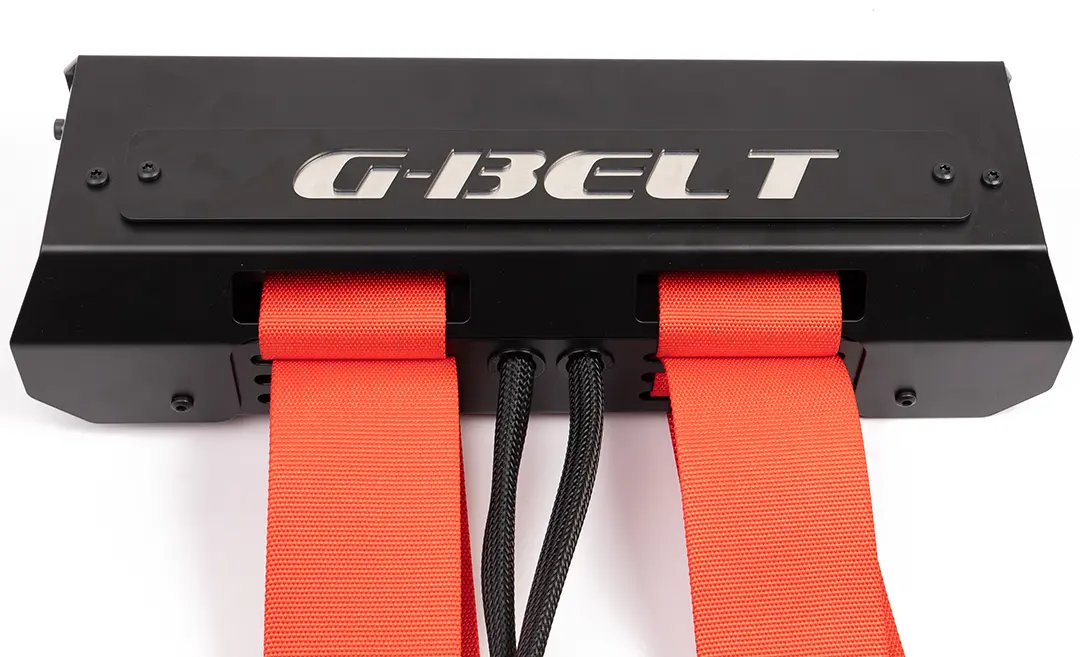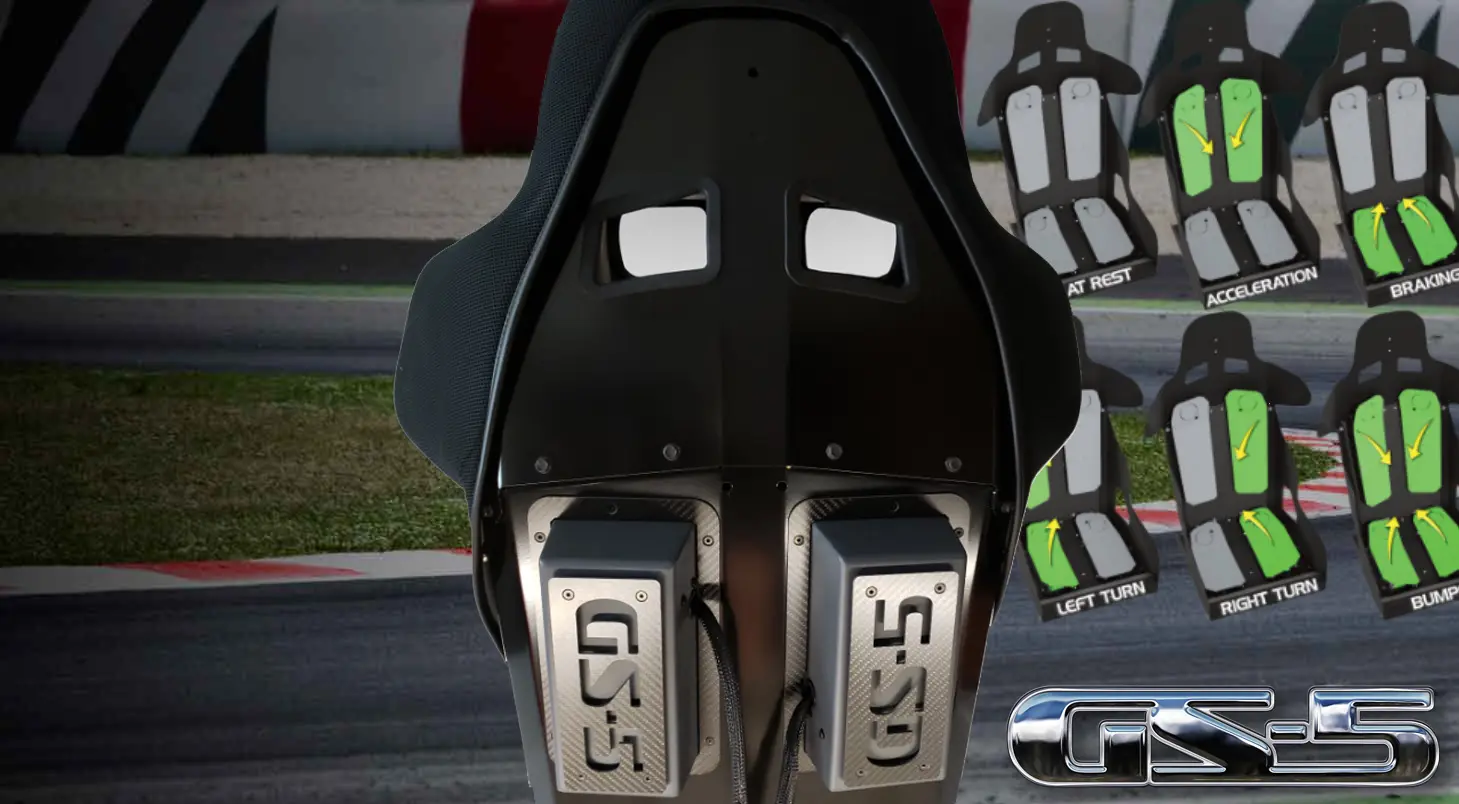To determine whether the G-Seat and G-Belt, when paired together, offer 6DOF (six degrees of freedom) body pressure simulation, we need to evaluate how they replicate the six axes of motion—surge, sway, heave, pitch, roll, and yaw—through pressure rather than physical movement of the entire cockpit. The traditional definition of 6DOF applies to motion platforms, but here we’re assessing if these systems can simulate the equivalent forces on the driver’s body in a way that corresponds to those axes. Let’s break it down based on their described capabilities:
GS-5 G-Seat Capabilities
- Two lower panels (under the driver): Move to apply pressure related to vertical G-forces (e.g., bumps, crests, dips) and lateral G-forces (cornering). They can also adjust for longitudinal forces (acceleration/braking) to some extent.
- Two back panels (behind the driver): Apply pressure to the driver’s sides for lateral G-forces and to the back for longitudinal G-forces (acceleration). They can move in opposition to simulate yaw (vehicle rotation).
G-Belt Capabilities
- Motorized harness over both shoulders: Tightens to simulate braking (chest pressure), releases for acceleration, tightens asymmetrically for cornering (one side more than the other), and adjusts for vertical G-forces or bumps.
Mapping to 6DOF Axes
- Surge (Forward/Backward)
- G-Seat: Back panels press against the driver’s back during acceleration, simulating forward G-forces. For braking, they may reduce pressure as the G-Belt takes over.
- G-Belt: Tightens across the chest during braking to mimic harness tension, loosens during acceleration.
- Result: Surge is fully simulated through sustained pressure (back for acceleration, chest for braking).
- Sway (Left/Right)
- G-Seat: Side panels (both lower and back) apply pressure to one side of the body during cornering, reflecting lateral G-forces.
- G-Belt: Tightens one harness strap more than the other to enhance the lateral sensation.
- Result: Sway is effectively simulated with sustained lateral pressure on the appropriate side.
- Heave (Up/Down)
- G-Seat: Lower panels adjust to simulate vertical G-forces—pressing up for bumps or crests, relaxing for dips.
- G-Belt: Adjusts tension to complement vertical forces (e.g., tightening during bumps to mimic upward pressure).
- Result: Heave is simulated through vertical pressure changes, sustained as needed.
- Pitch (Tilt Forward/Backward)
- G-Seat: Combination of back and lower panels can imply pitch—e.g., back panels pressing during acceleration (tilting back) and lower panels adjusting with G-Belt for braking (tilting forward).
- G-Belt: Chest pressure during braking enhances the forward tilt sensation; loosening during acceleration supports the rearward tilt.
- Result: Pitch is approximated through coordinated pressure, though it’s less direct than sway or surge, relying on the driver’s perception of body orientation.
- Roll (Tilt Side-to-Side)
- G-Seat: Side panels (lower and back) press on one side during cornering, simulating a tilt toward the outside of the turn.
- G-Belt: Asymmetrical tightening reinforces this by pulling one shoulder more, mimicking the lean.
- Result: Roll is well-simulated through lateral pressure gradients, sustained across the body.
- Yaw (Rotation Around Vertical Axis)
- G-Seat: Back and lower panels move in opposition (e.g., left side forward, right side back) to simulate vehicle rotation, such as oversteer or understeer.
- G-Belt: Asymmetrical tension can subtly enhance this, though its contribution is secondary.
- Result: Yaw is uniquely simulated via opposing pressures, sustained longer than a motion platform’s limited travel.
Analysis
The G-Seat and G-Belt together can apply sustained pressures to the driver’s body that correspond to all six degrees of freedom:
- Translational Axes (Surge, Sway, Heave): Directly and effectively simulated with clear pressure cues (back/chest for surge, sides for sway, vertical for heave).
- Rotational Axes (Pitch, Roll, Yaw): Simulated through combinations of pressure points. Roll and yaw are robustly handled (side pressure for roll, opposing pressures for yaw), while pitch is less explicit, relying on the interplay of back, lower, and chest pressures to imply tilting.
Unlike a 6DOF motion platform, which relies on physical cockpit movement to signal dynamics, the G-Seat and G-Belt use body pressure to simulate these forces with remarkable realism. While 6DOF systems deliver an initial surge—like acceleration or cornering—their actuators quickly hit travel limits, cutting off sustained feedback. In contrast, the G-Seat and G-Belt apply dynamic, sustained pressures at a 1000Hz update rate, keeping your brain immersed in seamless cues for surge, sway, heave, roll, yaw, and pitch. Pitch, though not physically tilted, feels vivid through indirect pressure shifts, trumping the fleeting jolts of traditional setups.
Conclusion
Together, the G-Seat and G-Belt create a racing simulator experience that outshines 6DOF motion systems. By delivering continuous, full-spectrum pressure feedback—rather than brief motion cues that fade—this combo mimics real-world racing forces with greater persistence and fidelity. It’s not just movement; it’s a realistic racing setup that keeps you in the driver’s seat, making it a standout feature of our best racing simulator designs—perfect for any home racing simulator or pro training rig.


Do the G-Seat + G-Belt Provide 6DOF Capabilities?